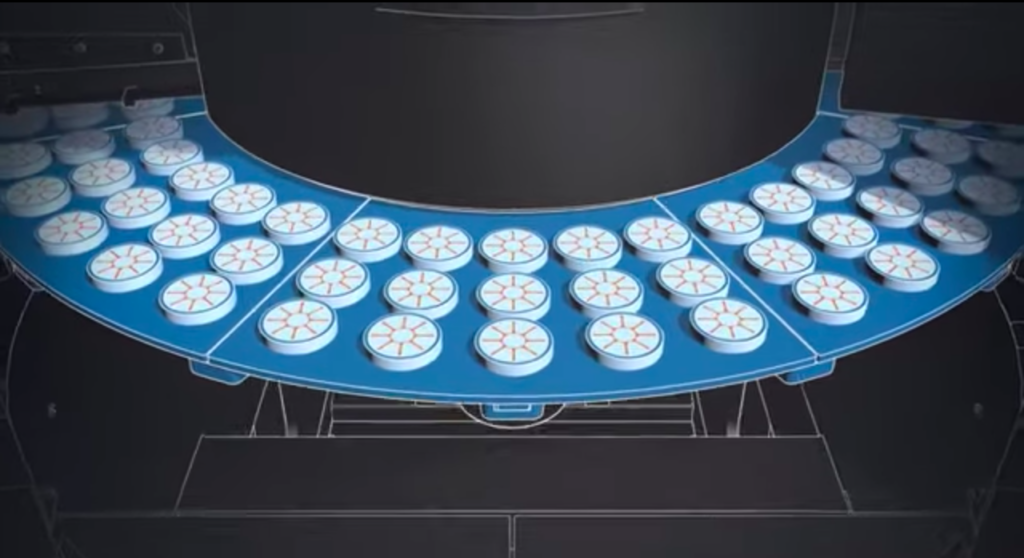The 3D printing mergers and acquisitions continue apace. On the heels of Markforged’s buyout of Digital Metal and Nano Dimension’s 12 percent purchase of Stratasys, 3D Systems (NYSE: DDD) has announced yet another acquisition. This time, the 3D printing stalwart has bought dp polar, a German developer of a unique additive manufacturing (AM) platform for continuous, high-speed 3D printing.
dp polar’s Unique 3D Printing Platform
Unlike traditional 3D printers, which typically rely on a Cartesian coordinate architecture and a moving print head, dp’s inkjet platform features a stationary print head that deposits material above a large-scale, segmented, rotating print platform. This makes it possible to 3D print continuously without the need to start and stop, in turn increasing throughput speed and reducing wear and vibration associated with print head movement.
Because the system is modular, other printing technologies, as well as pick-and-place robotics, can be integrated into the printer. The latter enables the embedding of functional parts, including electronics, into the body of a part as it is being 3D printed.
As an inkjet technology previously relying on Xaar printheads, dp polar’s platform is able to jet multiple materials to achieve a variety of physical characteristics, including elasticity, hardness, temperature resistance and color. It can also integrate pre-processing, production, and post-processing elements and connect to enterprise resource planning software. This enables the necessary traceability and quality assurance required for aerospace, healthcare, and other highly regulated markets.
3D Systems’ Plan for dp polar
3D Systems has been making quick moves into the material extrusion space, having purchased Kumovis for medical 3D printing and Titan Robotics for large-format extrusion. However, its own inkjet technology has been neglected for some time, with more focus going into its Figure 4 vat photopolymerization platform.
Now, however, 3D Systems is able to expand its own inkjet 3D printing from applications for prototyping and modeling to something capable of production. Combined with its Oqton manufacturing execution system (MES) software, the company suggests that it will be able to bring “true high-speed, mass production additive manufacturing to a breadth of industries including aerospace, automotive, foundries, consumer goods, and healthcare.”
Now, 3D Systems will be able to embark on a truly industrial approach to inkjet 3D printing, which has historically been limited to advanced modeling. The company explored a continuous 3D printing process last decade when it partnered with Google to potentially produce smartphone modules. The technology it worked on seemed to resemble the PrintValley architecture developed by Dutch research organization TNO. In fact, dp polar’s process has its own resemblance to that system.
“This acquisition is the next step in executing on our investment strategy to provide our customers with an industry-leading additive manufacturing solutions portfolio to address their critical applications challenges,” said Dr. Jeffrey Graves, President and CEO, 3D Systems. “dp polar has designed a very unique system that provides true high-volume production. The ability to print a broad range of materials, alongside the printer’s modular design that enables multiple processes in one high-speed platform not only increases productivity by orders of magnitude but also reduces the total cost of ownership. Particularly impressive is the level of machine intelligence embedded in the platform’s operating system, which enables continuous operation across the large, rotating print platform. This unique capability is central to the exceptional throughput, economics, and versatility of dp polar’s 3D printing system. By combining our renowned polymer materials portfolio with this first-to-market high-speed production technology, I believe we’ll affect a monumental shift in production workflows for high-value applications in industrial and healthcare markets.”
3D Printing Competition Heats up
Given the shakeups currently taking place in the 3D printing industry, it’s necessary to compare this transaction with those related to 3D Systems’ leading competitor, Stratasys. The latter company just purchased the 3D printing materials unit of Covestro, which in turn owned the AM photopolymer division of DMS. As 3DPrint.com Executive Editor Joris Peels mentioned, Covestro could have been quite valuable to 3D Systems had it not gone to its competitor.
If you look at the roadmap of Nano Dimension, an electronics 3D printer manufacturer, you can see some interesting parallels with what is happening at 3D Systems. The company’s DragonFly IV system is an inkjet machine that can deposit conductive inks and dielectric polymers to create unique printed circuit boards (PCBs). It is currently developing the tools to integrate further electronic elements using pick-and-place via its acquisition of Essemtec.
Because Nano Dimension recently purchased 12 percent of Stratasys, it could be seen as playing a crucial role in driving the company forward. This could mean, at some point, leveraging Stratasys’s own inkjet technology and the broader materials set offered by Covestro, to put into place the necessary pieces for its complete electronics 3D printing puzzle. Of course, if it is able to build something capable of 3D printing PCBs with all of the electronics required, it will next need to scale this technology so that it can 3D print electronics en masse. That would require something not unlike what dp polar offers.
In the end, then, this could all come down to 3D printed electronics, a sector that is secretly burgeoning in large part due to the semiconductor shortage and the need to circumvent legacy supply chains. We know that Apple, Google, Meta, and global militaries are interested in the technology. Could this be what AM has all been leading up to, 3D printing embedded electronics? It will certainly be a gamechanger for any and all manufacturers who use the technology.
The dp polar acquisition will close in the fourth quarter of 2022. 3D Systems will discuss its trajectory further in its upcoming earnings call, set for August 9, 2022 at 8:30 ET.
